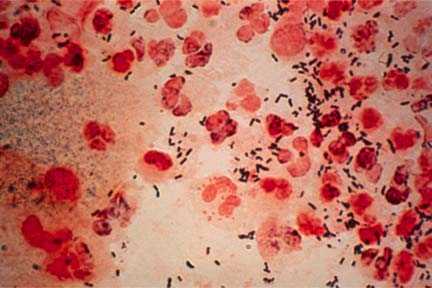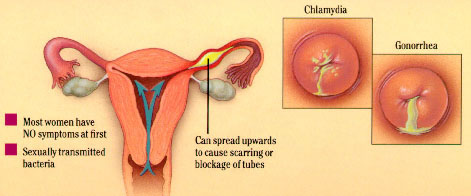
a. Photo

b. Description
Gonorrhea is an infectious sexually transmitted disease-caused by the
gonococcus bacterium, Neisseria gonorrhoeae.
c. How the organism attacks and spreads
Neisseria gonorrhoeae, or Gonorrhea, grows and multiplies quickly in
moist, warm areas of the body in the reproductive tract, the oral cavity,
and the rectum. Direct person to person contact spreads gonorrhea. It is
almost always transmitted through sexual contact
d. Most common victim to prey upon
The most common people to contract this disease are sexually active
and most often younger people from ages 15-30, who have multiple sex partners.
Gonorrhea occurs more frequently in urban areas than from rural areas.
Adult women have a three times higher chance of contracting gonorrhea than
in men, and girls aged 10 to 14 are four times more likely to get it boys
of the same age. Teenagers have the highest rates of infection than other
age groups. A man, who has intercourse with an infected partner, has a
30-50% chance of contracting the disease. However, a woman who has intercourse
has a much higher chance of 60-90%.
e. Where it is most likely to be found
Gonorrhea can occur in the reproductive organs, urethra, rectum and
throat.
f. Common injury done to victim
Gonorrhea has many undesirable effects. In men, the short-term effects
include painful urination, creamy or green pus-like penile discharge, and
testicular pain. The long-term effects include Epididymitis -which is an
inflammation of the testicles that can cause sterility. If Gonorrhea is
left untreated, the infection can spread to the testicles, which results
in sterility.

Other long-term effects are abscesses, ecotypic pregnancy, which is a pregnancy outside of the uterus, Perihepatitis that is an infection around the liver, and sterility. If the disease is untreated, the infection usually spreads from the cervix into the uterus and Fallopian tubes, causing pelvic inflammatory disease. Severe pain may occur, or the infection may linger with few or no symptoms, gradually damaging the tubes and rendering the woman sterile. Gonorrhea in pregnant women may be transmitted to the infant during birth and may, if untreated, cause a serious eye infection.
In both sexes the bacteria are able to enter the bloodstream, which can result in arthritis or heart inflammation, just to name a few.
g. Rate and degree of damage caused.
Symptoms usually develop within 2 days to 3 weeks of exposure. The
degree of damage is varied. Symptoms can come and just disappear again,
because the body heals itself. Or, the body can have a "normal" reaction
that includes having most of the symptoms. Or, the disease can go into
a very serious stage, which occurs if the disease is not treated, as outlined
above.
h. Number of victims
Annually, about 400,000 cases of gonorrhea are reported, but hundreds
of thousands more Americans may have gonorrhea and not realize it. For
example, in 1995, 392,848 cases of gonorrhea in the United States were
reported to the CDC (the U.S. Centers for Disease Control and Prevention).
But the Institute of Medicine estimates that around 800,000 cases of gonorrhea
occur in the United States annually.
i. Most effective weapons against the germ
Treatment is mostly effective in the early stages. The most commonly
used treatment is Penicillin. But biochemists have been finding and developing
an increasing number of penicillin-resistant strains. Some other effective
antibiotics are spectinomycin, tetracycline, and some newer ones called
cephalosporins. Ceftriaxone, a cephalosporin, can cure simple gonorrhea
with a single injection, including penicillin-resistant infections.
j. Bibliography